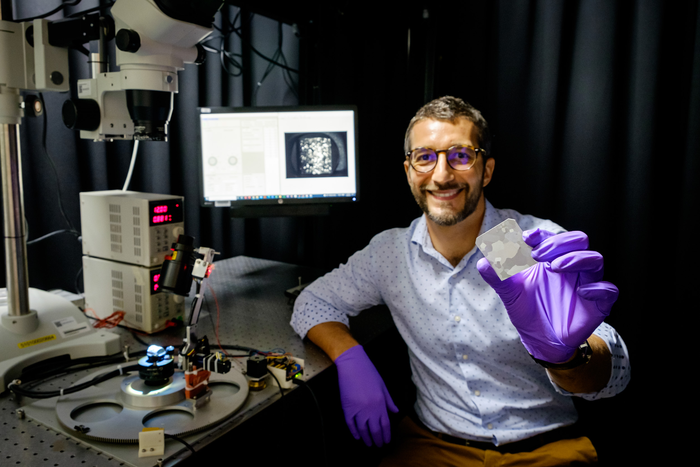Researchers from Nanyang Technological University, Singapore (NTU Singapore) have formulated a fast and economical imaging technique that can examine the structure of three-dimensional (3D)-printed metal parts and provide insights into the material’s quality.
 NTU Asst Prof Matteo Seita holding a piece of 3D-printed metal alloy, which can have its properties easily analyzed in 15 minutes by a new low-cost imaging system that uses an optical camera and machine learning. Image Credit: Nanyang Technological University, Singapore.
NTU Asst Prof Matteo Seita holding a piece of 3D-printed metal alloy, which can have its properties easily analyzed in 15 minutes by a new low-cost imaging system that uses an optical camera and machine learning. Image Credit: Nanyang Technological University, Singapore.
The majority of 3D-printed metal alloys comprise numerous microscopic crystals, which vary in size, shape and atomic lattice orientation. By drawing out this information, researchers and engineers can deduce the alloy’s properties, such as toughness and strength. This is like observing wood grain, where wood is strongest when the grain is unbroken in the same direction.
This recent made-in-NTU technology could be advantageous, for example, in the aerospace industry, where a swift and economical assessment of mission-critical components — fan blades turbine, and other components — could be revolutionary for the maintenance, repair and overhaul industry.
So far, examining this ‘microstructure’ in 3D printed metal alloys has been realized through arduous and slow measurements using scanning electron microscopes, which cost between S$100,000 and S$2 million.
The technique formulated by Nanyang Assistant Professor Matteo Seita and his team offers the same quality of information within minutes by using a system comprising a flashlight, an optical camera and a notebook computer that works a proprietary machine-learning software designed by the team — with the hardware costing approximately S$25,000.
The team’s new technique first necessitates treating the metal surface with chemicals to expose the microstructure, then positioning the sample facing the camera, and taking numerous optical images as the flashlight irradiates the metal from many directions.
The software then examines the patterns generated by light that is reflected off the surface of diverse metal crystals and infers their orientation. The whole process requires roughly 15 minutes to complete.
The team’s findings have been reported in the peer-reviewed scientific journal npj Computational Materials by the Nature Publishing Group last month.
Using our inexpensive and fast-imaging method, we can easily tell good 3D-printed metal parts from the faulty ones. Currently, it is impossible to tell the difference unless we assess the material’s microstructure in detail.
Assistant Professor Matteo Seita, School of Mechanical and Aerospace Engineering and School of Materials Science and Engineering, NTU
“No two 3D-printed metal parts are created equal, even though they may have been produced using the same technique and have the same geometry. Conceptually, this is akin to how two otherwise identical wooden artefacts may each possess a different grain structure,” Assistant Professor Seita added.
New Imaging Method a Boost for 3D Printing Certification and Quality Assessment
Asst Prof Seita is certain that their ground-breaking imaging technique has the potential to streamline the certification and quality assessment of metal alloy parts formed by 3D printing, also called additive manufacturing.
One of the most frequently used methods to 3D print metal parts uses a high-powered laser to melt metal powders and join them together, layer by layer until the complete product is printed.
However, the microstructure and consequently the quality of the resulting printed metal rely on more than a few factors, including how rapid or powerful the laser is, how much time is set for the metal to cool before the subsequent layer is melted, and even the brand and type of metal powders employed.
This is the reason why the same design printed by two diverse machines or production houses may result in components of varying quality. Rather than using a complex computer program to assess the crystal orientation from the optical signals obtained, the “smart software” designed by Asst Prof Seita and his team uses a neutral network — imitating how the human brain creates association and processes thought.
The researchers then applied machine learning to program the software, by inputting hundreds of optical images.
Ultimately, their software learned how to forecast the arrangement of crystals in the metal from the images, based on variances in how light disperses off the metal surface. It was then tested to be able to develop a full ‘crystal orientation map’, which offers complete information on the crystal size, shape and atomic lattice arrangement.
To commercialize their technique, the researchers are currently in talks with NTUitive, NTU’s innovation and enterprise company, to explore the option of beginning a spin-off company or to license their patent to industry players who are keen.
Journal Reference:
Wittwer, M. & Seita, M. (2022) A machine learning approach to map crystal orientation by optical microscopy. npj Computational Materials. doi.org/10.1038/s41524-021-00688-1.